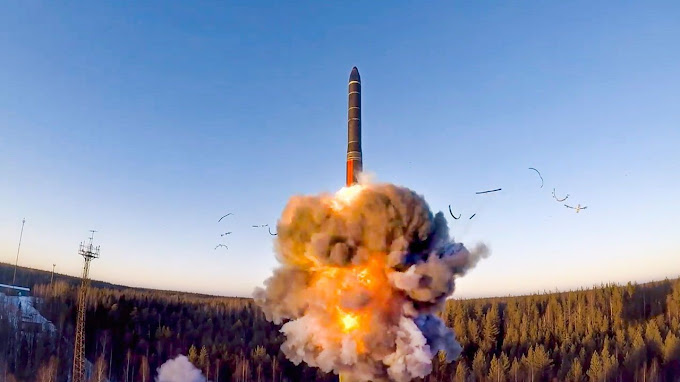Destroyer of worlds
How to stop a three-way nuclear arms-race
America, China and Russia must agree on mutual restraints before it’s too late
 A rocket launches from a missile system during a test at the Plesetsk facility in north-western Russia.
A rocket launches from a missile system during a test at the Plesetsk facility in north-western Russia.In life and in a recent film, Robert Oppenheimer, the father of the atomic bomb, was haunted by the idea that “I am become Death, destroyer of worlds.”
The Cuban missile crisis of 1962 nearly brought annihilation.
Fortunately the superpowers stepped back from the brink and agreed on arms-control deals that eventually shrank nuclear stockpiles, and did more besides.
Now the world is entering a new nuclear arms-race—one that may be harder to stop.
Instability is increasing because of Vladimir Putin’s nuclear threats in Ukraine and China’s rapid build-up of weapons.
And arms control is collapsing.
First Russia and later America stopped exchanging information under New start, the last deal limiting their arsenals.
The treaty will expire in February 2026, and there is little sign of a replacement.
China has never cared for such curbs. America, China and Russia need to start talking now, before another Cuban-style crisis occurs.
Developed during the cold war, the notion of “mutual assured destruction” involves mind-bending logic.
But now deterrence is becoming even more complex because of the prospect of three near-peer nuclear powers.
The balance of terror is also being upended by new kinds of missiles and sensors, and by the possibility of artificial intelligence influencing decisions.
Until now, America and Russia accepted limits on the basis of parity, assuming their arsenals of 5,000-6,000 warheads each would be enough to deter each other and smaller threats.
China used to rely on a “minimal deterrent” of a few hundred warheads.
But it wants more weapons and to maintain them at a higher level of alert: it could have 1,500 warheads by 2035, according to the Pentagon.
Given their “friendship with no limits”, Russia and China could act as military allies in a crisis.
Should America match the combined arsenals of Russia and China?
Some experts think that, at the very least, it needs more weapons.
From 2026 they want to “upload” warheads, currently held in reserve, onto deployed missiles and bombers.
Many in Congress are calling for a nuclear sea-launched cruise missile (slcm-n) to plug a perceived gap in the escalation ladder.
Such moves could make everything worse.
China or Russia may try to match America’s bigger arsenal; India could build up in response to China; Pakistan in reaction to India; and so on.
President Joe Biden is rightly resisting a huge new build-up, which should be considered only if diplomacy is exhausted.
America is right to keep modernising its triad (of land-, sea- and air-launched nukes), but stick to limits on the number of warheads beyond 2026, providing Russia does the same.
It should keep open its offer to talk without preconditions with China and Russia.
Stability requires a mix of threat and reassurance.
The big powers need to discuss all aspects of their nuclear enterprise, not least missile defences, slcm-n and tactical weapons.
They must also think of space and cyberspace, where the first shot of the next war may be fired.
A call by America, Britain and France to limit the role of artificial intelligence by ensuring there is a “man in the loop” using nukes makes sense.
America and Russia should resume notifications under New start.
China should take part in more confidence-building measures, such as missile-launch notifications.
China’s belief that such safety-nets encourage risk-taking is wrong.
Nobody, including the leaders of the People’s Republic, benefits from unrestrained nuclear rivalry.
It would soak up vast resources: Russia cannot afford it.
And in a nuclear-armed world without limits, everybody is on a high wire.
Negotiated restraints are the only way to avert Oppenheimer’s dread, in the film, of “a chain reaction that would destroy the entire world”.
0 comments:
Publicar un comentario